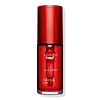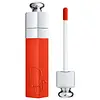What's inside
What's inside
 Key Ingredients
Key Ingredients

 Benefits
Benefits

 Concerns
Concerns

 Ingredients Side-by-side
Ingredients Side-by-side

Water
Skin ConditioningGlycerin
HumectantAloe Barbadensis Leaf Juice
Skin ConditioningRubus Idaeus Fruit Water
MaskingPentylene Glycol
Skin ConditioningPhenoxyethanol
PreservativeParfum
MaskingCaesalpinia Spinosa Gum
Skin ConditioningSodium Citrate
BufferingAmmonium Glycyrrhizate
MaskingCarbomer
Emulsion StabilisingPPG-26-Buteth-26
Skin ConditioningEthylhexylglycerin
Skin ConditioningTamarindus Indica Seed Gum
Emulsion StabilisingPEG-40 Hydrogenated Castor Oil
EmulsifyingSodium Hyaluronate
HumectantSodium Dehydroacetate
PreservativeButylene Glycol
HumectantPotassium Sorbate
PreservativeSodium Benzoate
MaskingCitric Acid
BufferingFurcellaria Lumbricalis Extract
Skin ConditioningCamellia Sinensis Leaf Extract
AntimicrobialLapsana Communis Flower/Leaf/Stem Extract
Skin ConditioningMaris Sal
Skin ConditioningMica
Cosmetic ColorantTin Oxide
AbrasiveSilica
AbrasiveCalcium Aluminum Borosilicate
Calcium Sodium Borosilicate
Synthetic Fluorphlogopite
CI 77891
Cosmetic ColorantCI 77491
Cosmetic ColorantCI 15850
Cosmetic ColorantCI 15985
Cosmetic ColorantCI 42090
Cosmetic ColorantCI 75470
Cosmetic ColorantCI 19140
Cosmetic ColorantCI 45410
Cosmetic ColorantCI 73360
Cosmetic ColorantCI 17200
Cosmetic ColorantCI 45380
Cosmetic ColorantCI 77742
Cosmetic ColorantWater, Glycerin, Aloe Barbadensis Leaf Juice, Rubus Idaeus Fruit Water, Pentylene Glycol, Phenoxyethanol, Parfum, Caesalpinia Spinosa Gum, Sodium Citrate, Ammonium Glycyrrhizate, Carbomer, PPG-26-Buteth-26, Ethylhexylglycerin, Tamarindus Indica Seed Gum, PEG-40 Hydrogenated Castor Oil, Sodium Hyaluronate, Sodium Dehydroacetate, Butylene Glycol, Potassium Sorbate, Sodium Benzoate, Citric Acid, Furcellaria Lumbricalis Extract, Camellia Sinensis Leaf Extract, Lapsana Communis Flower/Leaf/Stem Extract, Maris Sal, Mica, Tin Oxide, Silica, Calcium Aluminum Borosilicate, Calcium Sodium Borosilicate, Synthetic Fluorphlogopite, CI 77891, CI 77491, CI 15850, CI 15985, CI 42090, CI 75470, CI 19140, CI 45410, CI 73360, CI 17200, CI 45380, CI 77742
Water
Skin ConditioningGlycerin
HumectantMethyl Hydrogenated Rosinate
PerfumingButylene Glycol
HumectantPolyglyceryl-2 Triisostearate
EmulsifyingAlcohol
AntimicrobialPolyglycerin-3
HumectantHydroxyethyl Acrylate/Sodium Acryloyldimethyl Taurate Copolymer
Emulsion StabilisingSqualane
EmollientPolyurethane-35
1,2-Hexanediol
Skin ConditioningLecithin
EmollientMenthoxypropanediol
MaskingParfum
MaskingTrimethylolpropane Triisostearate
EmollientSodium Hyaluronate
HumectantPolysorbate 60
EmulsifyingHydroxyacetophenone
AntioxidantSodium Benzoate
MaskingPrunus Avium Seed Oil
EmollientAmmonium Glycyrrhizate
MaskingSorbitan Isostearate
EmulsifyingTocopherol
AntioxidantMethylpropanediol
SolventEthyl Vanillin
MaskingCitric Acid
BufferingCaprylyl Glycol
EmollientCapsicum Frutescens Fruit Extract
Skin ConditioningPropyl Gallate
AntioxidantPhenylpropanol
MaskingPentaerythrityl Tetra-Di-T-Butyl Hydroxyhydrocinnamate
AntioxidantCI 73360
Cosmetic ColorantCI 15985
Cosmetic ColorantCI 15850
Cosmetic ColorantCI 45410
Cosmetic ColorantCI 17200
Cosmetic ColorantWater, Glycerin, Methyl Hydrogenated Rosinate, Butylene Glycol, Polyglyceryl-2 Triisostearate, Alcohol, Polyglycerin-3, Hydroxyethyl Acrylate/Sodium Acryloyldimethyl Taurate Copolymer, Squalane, Polyurethane-35, 1,2-Hexanediol, Lecithin, Menthoxypropanediol, Parfum, Trimethylolpropane Triisostearate, Sodium Hyaluronate, Polysorbate 60, Hydroxyacetophenone, Sodium Benzoate, Prunus Avium Seed Oil, Ammonium Glycyrrhizate, Sorbitan Isostearate, Tocopherol, Methylpropanediol, Ethyl Vanillin, Citric Acid, Caprylyl Glycol, Capsicum Frutescens Fruit Extract, Propyl Gallate, Phenylpropanol, Pentaerythrityl Tetra-Di-T-Butyl Hydroxyhydrocinnamate, CI 73360, CI 15985, CI 15850, CI 45410, CI 17200
Ingredients Explained
These ingredients are found in both products.
Ingredients higher up in an ingredient list are typically present in a larger amount.
We don't have a description for Ammonium Glycyrrhizate yet.
Butylene Glycol (or BG) is used within cosmetic products for a few different reasons:
Overall, Butylene Glycol is a safe and well-rounded ingredient that works well with other ingredients.
Though this ingredient works well with most skin types, some people with sensitive skin may experience a reaction such as allergic rashes, closed comedones, or itchiness.
Learn more about Butylene GlycolCi 15850 is the pigment color red. It is an azo dye and created synthetically.
Azo dyes need to be thoroughly purified before use. This allows them to be more stable and longer-lasting.
This ingredient is common in foundations, lipsticks, and blushes. This color is described as brown/orangey red.
It has many secondary names such as Red 6 and Red 7. According to a manufacturer, Red 6 usually contains aluminum.
Learn more about CI 15850Ci 15985 is a dye made from petroleum. It is synthetically created and approved by the FDA for use in foods and cosmetics.
The color of this dye is orange/yellow.
This ingredient can be found in makeup, sun care, and skincare.
Learn more about CI 15985Ci 17200 is a synthetic reddish-purple dye.
CI 45410 is a synthetic red-pigment and dye.
It often goes by both Red 28 or Red 27; manufacturers label both ingredients as CI 45410.
This dye is commonly found in makeup because it imparts a vivid color. Some types of this dye change color based on pH level and interaction with moisture:
Your skin has a natural pH of around 4.5 - 5.5.
According to the FDA, CI 45410 is not permitted for use in eye products.
Red 27 is a flourescein dye and commonly used as a fluorescent tracer in medicine.
Learn more about CI 45410Ci 73360 is a synthetic red-pink dye.
Citric Acid is an alpha hydroxy acid (AHA) naturally found in citrus fruits like oranges, lemons, and limes.
Like other AHAs, citric acid can exfoliate skin by breaking down the bonds that hold dead skin cells together. This helps reveal smoother and brighter skin underneath.
However, this exfoliating effect only happens at high concentrations (20%) which can be hard to find in cosmetic products.
Due to this, citric acid is usually included in small amounts as a pH adjuster. This helps keep products slightly more acidic and compatible with skin's natural pH.
In skincare formulas, citric acid can:
While it can provide some skin benefits, research shows lactic acid and glycolic acid are generally more effective and less irritating exfoliants.
Most citric acid used in skincare today is made by fermenting sugars (usually from molasses). This synthetic version is identical to the natural citrus form but easier to stabilize and use in formulations.
Read more about some other popular AHA's here:
Learn more about Citric AcidGlycerin is already naturally found in your skin. It helps moisturize and protect your skin.
A study from 2016 found glycerin to be more effective as a humectant than AHAs and hyaluronic acid.
As a humectant, it helps the skin stay hydrated by pulling moisture to your skin. The low molecular weight of glycerin allows it to pull moisture into the deeper layers of your skin.
Hydrated skin improves your skin barrier; Your skin barrier helps protect against irritants and bacteria.
Glycerin has also been found to have antimicrobial and antiviral properties. Due to these properties, glycerin is often used in wound and burn treatments.
In cosmetics, glycerin is usually derived from plants such as soybean or palm. However, it can also be sourced from animals, such as tallow or animal fat.
This ingredient is organic, colorless, odorless, and non-toxic.
Glycerin is the name for this ingredient in American English. British English uses Glycerol/Glycerine.
Learn more about GlycerinParfum is a catch-all term for an ingredient or more that is used to give a scent to products.
Also called "fragrance", this ingredient can be a blend of hundreds of chemicals or plant oils. This means every product with "fragrance" or "parfum" in the ingredients list is a different mixture.
For instance, Habanolide is a proprietary trade name for a specific aroma chemical. When used as a fragrance ingredient in cosmetics, most aroma chemicals fall under the broad labeling category of “FRAGRANCE” or “PARFUM” according to EU and US regulations.
The term 'parfum' or 'fragrance' is not regulated in many countries. In many cases, it is up to the brand to define this term.
For instance, many brands choose to label themselves as "fragrance-free" because they are not using synthetic fragrances. However, their products may still contain ingredients such as essential oils that are considered a fragrance by INCI standards.
One example is Calendula flower extract. Calendula is an essential oil that still imparts a scent or 'fragrance'.
Depending on the blend, the ingredients in the mixture can cause allergies and sensitivities on the skin. Some ingredients that are known EU allergens include linalool and citronellol.
Parfum can also be used to mask or cover an unpleasant scent.
The bottom line is: not all fragrances/parfum/ingredients are created equally. If you are worried about fragrances, we recommend taking a closer look at an ingredient. And of course, we always recommend speaking with a professional.
Learn more about ParfumSodium Benzoate is a preservative. It's used in both cosmetic and food products to inhibit the growth of mold and bacteria. It is typically produced synthetically.
Both the US FDA and EU Health Committee have approved the use of sodium benzoate. In the US, levels of 0.1% (of the total product) are allowed.
Sodium benzoate works as a preservative by inhibiting the growth of bacteria inside of cells. It prevents the cell from fermenting a type of sugar using an enzyme called phosphofructokinase.
It is the salt of benzoic acid. Foods containing sodium benzoate include soda, salad dressings, condiments, fruit juices, wines, and snack foods.
Studies for using ascorbic acid and sodium benzoate in cosmetics are lacking, especially in skincare routines with multiple steps.
We always recommend speaking with a professional, such as a dermatologist, if you have any concerns.
Learn more about Sodium BenzoateSodium Hyaluronate is hyaluronic acid's salt form. It is commonly derived from the sodium salt of hyaluronic acid.
Like hyaluronic acid, it is great at holding water and acts as a humectant. This makes it a great skin hydrating ingredient.
Sodium Hyaluronate is naturally occurring in our bodies and is mostly found in eye fluid and joints.
These are some other common types of Hyaluronic Acid:
Learn more about Sodium HyaluronateWater. It's the most common cosmetic ingredient of all. You'll usually see it at the top of ingredient lists, meaning that it makes up the largest part of the product.
So why is it so popular? Water most often acts as a solvent - this means that it helps dissolve other ingredients into the formulation.
You'll also recognize water as that liquid we all need to stay alive. If you see this, drink a glass of water. Stay hydrated!
Learn more about Water